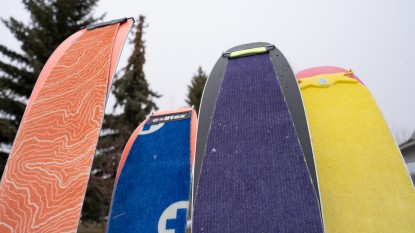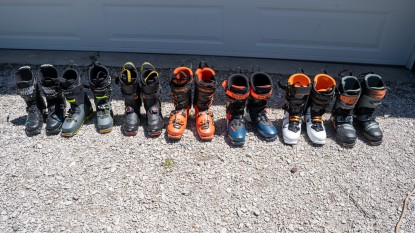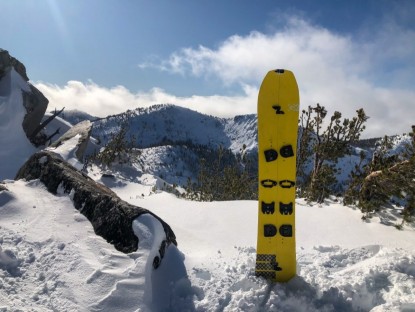Climbing skins are mystifying and magical. At first glance, they are simple. When we really sit back and ponder, they are quite miraculous. The way they stick to both ski and snow and release the stick from each as needed, is paradoxical and perplexing. To do so in such a harsh climate and under quite intense use (think about it: we literally stomp on them on steep, gnarly mountains for days, weeks, and years) is amazing. All products on the market do the job, but some are better than others. Similarly, some products are more catered to particular usage patterns and niches. Differences between products are very subtle; even more so than most products. In our comprehensive, comparative review of skins, we found that differences in performance were sometimes imperceptible to the inattentive. It is only after days and days of comparative use, assessing with decades of perspective, that we could discern and articulate important, meaningful differences. Our hard work results in the aforementioned comparative review as well as this buying advice.
Backing up a little, let us explain the category a little further. At its simplest, this category unites all pieces of fabric and laminates that backcountry skiers and ski mountaineers place on the bottom of their skis for upward traction. The goal of backcountry skiers is to climb up wild, snowy slopes and ski back down them. Backcountry ski gear is different than resort gear, primarily because of this need to ascend first. The downhill component of a backcountry ski day is fairly similar to that at a resort. The uphill part, though, has very different equipment requirements. We must move the equipment against gravity, so weight is significant. We are sliding skis uphill while relying on those same skis for traction. An uphill stride requires more and a different range of motion than downhill alpine turns. The boots we use are lighter and articulate at the ankle for uphill walking. The bindings we use are also lighter and allow for a free heel for the uphill. The skis we use are lighter and hopefully more versatile. We have outlined advice on choosing equipment in these categories elsewhere on the site. Lastly, we must make our otherwise slippery skis grip the slope. Sure, one could walk and carry the skis on one's back. The main issue with this, however, is flotation. Keeping skis on feet spreads ones weight over greater surface area and thereby keeps the skier out of the depths of the snow. And that makes travel more efficient. Climbing skins are the traction. Traction requires high friction, while sliding your skis up the mountain requires low friction. Conflicting demands, or intriguing engineering problem?
Modern skins are made up of a glue side that sticks to your skis, a fabric backing, and a fuzzy, snow-side with a distinct “nap”. The glue sticks to the skin and stays there. It sticks temporarily to the ski for usage, and then sticks, again temporarily, to itself for storage. It does this while permanently staying stuck to the fabric. The fabric side allows forward glide but backward traction. “Glide” and “traction” are relative; they don't grip like metal crampons nor do they glide like waxed p-tex. Originally, and an insight into the naming convention, climbing skins were made of actual seal hide. A seal's fur is short, stiff, and directional. Cut appropriately (apparently… none of us have used actual animal skin climbing skins), seal skins allow forward progress and backward grip. Modern materials mimic seal skin in their own ways.
The Types of Climbing Skins Available
Skins across the entire spectrum have more in common than they have differences. As noted above, variations are subtle, and all skins can work in all applications. The easiest way to divide them, initially, is by material.
Nylon
We divide skins by the material in the grippy, fibrous part of the product. Full nylon skins are durable and grippy, but with limited glide. The end product is heavier and bulkier than the alternatives, but also less expensive.
Mohair
All-natural mohair, from the hair of the Angora goat, can be woven into excellent skins. Mohair skins glide really well, especially on dry powder snow, and pack down quite small and light, but are less durable and more expensive than nylon.
Nylon/Mohair Blends
As you may guess, blended skins mix the attributes of their pure cousins. The blended construction provides a compromise on grip, glide, bulk, and durability and most blended skins seem to go for a ratio of mohair to nylon that is around 70:30.
Compatibility
Skins are sold in one of two major configurations. They can be universally compatible, or specific to one make and model of ski. Universal skins are, just as the name implies, adaptable at the time of initial purchase to any ski on the market. You will have to do at least a little irreversible trimming, if not a full construction of the components, but these products work on all skis. On the other hand, some backcountry ski companies sell ready-to-use skins for just their skis. The skin is matched to the size and model of ski, and it arrives ready to go. The skis and skins may be manufactured by the same company, but more likely the skins are licensed from a dedicated skin manufacturer and co-branded by the ski maker.
Glue Type
We can divide the types of adhesive into two major categories. Usage of those two different categories is different enough to influence your decision making. For lack of better terminology, we call the two adhesive types “traditional” and “cleanable”. As you might infer, traditional glue is more well proven, familiar, and in more widespread use. It appears on most climbing skins and is likely what you or your friends have already used. No glue maintains optimal performance forever. But traditional glue keeps its initial performance characteristics longer than the alternative. In our experience, you can get a season or two of performance from traditional glue before disposing of the skins or replacing the glue. Skin glue fails on account of a little bit of glue degradation and a lot of debris accumulation. Skins with cleanable adhesive accumulate debris in a way that more rapidly degrades their stickiness, but one can — and, really, needs to — clean them quickly to reliably return them to functionality.
Applying actual usage numbers is a fraught exercise, but we can summarize in order to give a rough comparison. All else equal, traditional glue might last 100 ski touring days before requiring re-gluing. The re-gluing process requires a few hours of active labor, special tools and patience, and then a day or two of drying and curing. The re-glued skins will last about 80 days before requiring the same process over again (factory applied glue is more reliable and durable than replacement glue).
By comparison, new cleanable skins will go 40 days or so before requiring a 5-minute cleaning procedure (unless the recommended cleaning procedure requires dunking them in water and drying them back out). Once cleaned, your skins are ready to go for another 25-30 days before requiring the same quick cleaning procedure. In either case, you can re-glue or clean until the fabric side is worn down. Wearing out skins may take thousands of days for nylon, half that for nylon/mohair blends, and a couple hundred for all mohair.
A clever and patient reader will deduce that cleanable skins require, overall, less maintenance. Our test leadership has reached the same conclusion and, especially when reliable function matters, chooses cleanable glues nowadays. However, it is an unfamiliar option to many and traditional glue still works just fine, too.
How to Choose Skins for Backcountry Skiing
Can I get Dedicated Skins for my Skis?
The first step in choosing skins is to investigate whether the skis you use or are interested in using are available with dedicated skins. In our experience, most dedicated co-branded skins are worth choosing over the universal options. First of all, your decision-making and setup is done for you. Next, most co-branded, dedicated skins are good designs made with reputable materials and methods. Because universal compatibility is not an issue, the tip and tail attachments (included to augment the glue in securing the skin to ski) can be more sophisticated and integrated. Usually, the ski tip and skin of dedicated products are shaped to work together to maximize security and ease of use. Most co-branded skins are blended mohair and nylon, which seems to strike an appropriate balance of all the performance criteria. There are certain circumstances in which we recommend choosing universal skins even if there are co-branded skins available to you. We summarize some of those in the rest of this article.
What Works for Most People
Most skiers, whether the most diehard or casual user, will be best served by skins right in the middle of the pack. Because performance criteria are inherently at odds, there will always be compromises. We want our skins to both grip and glide. Better glide means less grip and vice versa. We expose our skins to pounding punishment on miles and miles of rough ground, but we want them to pack tiny for the way down. Durable skins are heavier, and lighter skins are flimsier. We need the glue to hold tenaciously to ski bases but disengage from the ski and from itself for easy usage.
In our experience and testing, we have found that close to 75% of the market will be best served by nylon/mohair blended skins. If your skis can be equipped with dedicated, purpose-built, co-branded skins that are a nylon/mohair blend, we recommend those, most of the time. If dedicated, appropriate skins are not available, we recommend universal, blended skins.
Your Use Patterns and Preferences. Are You an Exception?
Generally, as noted above, we recommend nylon/mohair blended skins for almost everyone. Whether co-branded with your skis, or as universal trim-to-fit products, we can say on good authority that these will strike just the right balance for you. However, there are exceptions.
First of all, we have found that some skins have glue that is just too sticky. If the skins that come with the skis you use are in this category, you will do better with universal skins. Just a handful of skins on the market (and fewer all the time) are made with glue that requires super strenuous wrestling to disengage from itself in deployment. We do not recommend those skins. Read reviews and test them out yourself to see what too-sticky skins are like.
Next, if you know that you will require above-normal durability (essentially, for long-distance, expedition skiing on hard corn snow. High Sierra, we're looking at you.Also, Cascades Volcanoes), consider full nylon skins. Since all of the co-branded skins we have seen are mohair/nylon blends, this is an instance in which you may choose to forego the co-branded skins. The difference in durability between full nylon and blended skins becomes clear only after multiple heavy-duty seasons of use. Whether you are choosing full nylon over co-branded dedicated skins or over blended universal products, they will be heavier, bulkier, with poorer glide. They will grip slightly better, and wear far longer.
The next exception to our rule is for those that are seeking better glide and ultralight fast performance. Full mohair skins do indeed glide better than blends or full nylon. When the snow is dry and wintry, the difference is most profound, but there is a noticeable difference in all snow conditions. Full mohair skins are made of flimsier fabric that is more prone to both traumatic damage and wear from prolonged use. The lighter fabric is also more vulnerable to peeling back in use and allowing snow to sneak in between ski and skin. For high-tempo ski touring and mountaineering, especially on dry snow and despite the drawbacks, full mohair skins can be a great way to save weight and energy.
Finally, do you truly require much greater grip? New skinners slip on their skins, regardless of what skins those are; it is only with experience and practice that skins feel truly secure. Even then, even the best skins and skinners will slip on occasion. It happens to everyone. Skin traction is not perfect. In most settings that learning curve is steep and within a few tours the skier, especially when practiced with intention and instruction, will find adequate grip on any skin. For a small number of people, in specific, rare settings, extra grip is actually required. The skins with the greatest grip are heavy and glide poorly. This poor glide slows down every step. The cost of extra grip is more energy expended. It is true, some people and circumstances require the skins with the greatest traction. But those instances are fewer than you might imagine. Purchase carefully.














